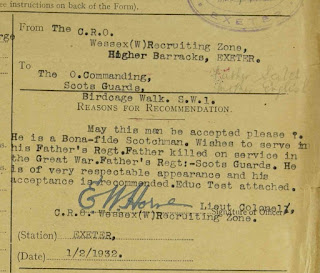 |
| Tiverton : Former Belmont Hospital cc-by-sa/2.0 - © Lewis Clarke - geograph.org.uk/p/4587272 Now known as Perreyman Court, this used to be a hospital and workhouse. |
Frederick Southcott, son of William Southcott and Temperance Cosway, married Eliza Harris in Tiverton, in 1879. They had five children:
- Lucy Southcott b. 30 Aug 1880, bap. 13 Sep 1880 at St Peter's Church, Tiverton. (Died in the first quarter of 1881, aged 0.)
- Alice Southcott b. 22 Mar 1882, bap. 14 Apr 1882 at St Peter's Church, Tiverton. (Died at the beginning of 1885, aged 3.)
- Arthur Southcott b. 30 Jul 1883, bap. 9 Aug 1883 at St Peter's.
- Frederick William Southcott b. 27 Feb 1886, bap. 28 Mar 1886 at St Peter's Church, Tiverton. (Died in the 2nd quarter of 1886, aged 0.)
- Bessie Southcott b. 1889, bap. 12 Feb 1892 at St Peter's, Tiverton.
In 1881, Frederick Southcott (29) Milk Carrier (these listings of Victorian Occupations 'helpfully' says this is "Someone who carries milk". No doubt from dairy to customer in a hand cart as shown here) and Eliza (25) were living in Kiddles Court, off Fore Street, Tiverton.
However, on the 1886 baptism, under what is usually the father's occupation, was listed "Inmate of Workhouse". And on Bessie's baptism in 1892, their address was also given as Tiverton Union, i.e. Workhouse.
In 1891, Frederick, Eliza, Arthur and Bessie were all Inmates at The Tiverton Union Workhouse, as the records explain that Frederick Southcott, former milk carrier, had become "Blind not from birth".
Without buying all the death certificates, it's not possible to know for sure, but the fact that two of the children died around the same time, in 1885 and 1886, tends to suggest that disease, rather than accident, was implicated. Smallpox was a common killer in nineteenth century Britain, and was responsible for a third of all human blindness. The risk of death after contracting the disease was about 30%, with higher rates among babies.
Arthur went to sea, joining the Royal Navy in March 1899, when he will have been 15½. While Bessie was enrolled in Elmore School in 1899, with her address on the school records once again listed as "Workhouse".
Bessie and her parents were still in the Workhouse in 1901, after which she just disappears. Art Southcott (17), in 1901, was a Boy 1st Class, part of the crew of HMS Nile, while she was the coast guard ship at Devonport.
Frederick Southcott died in 1906, undoubtedly still in the Workhouse.
Arthur served in the Royal Navy until 4 Jun 1908, when he was Invalided, so by 1911, Arthur Southcott (27) was back in the Tiverton Union Workhouse. Eliza was still in the Workhouse in 1911 and died in 1913.
Utterly heart-breaking that accident or illness had consigned them to what was undoubtedly a miserable existence for the rest of their lives.









